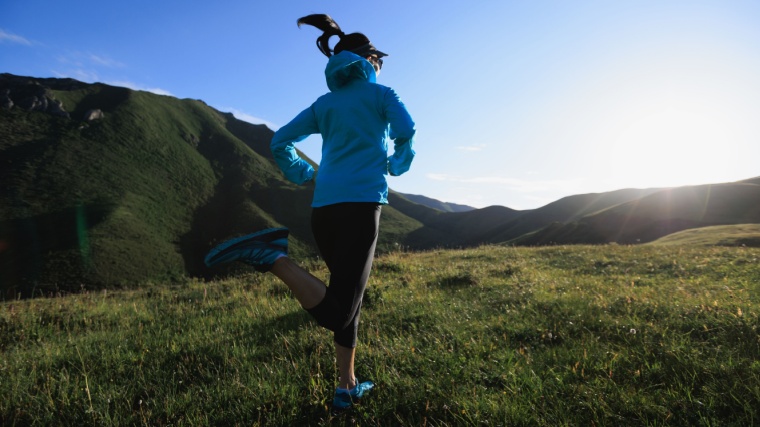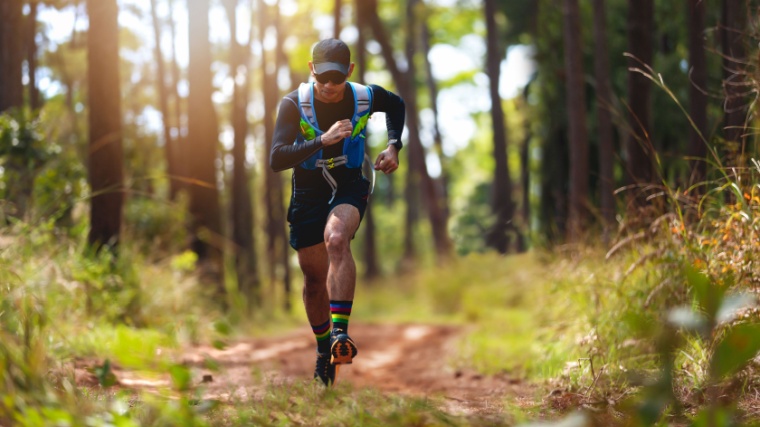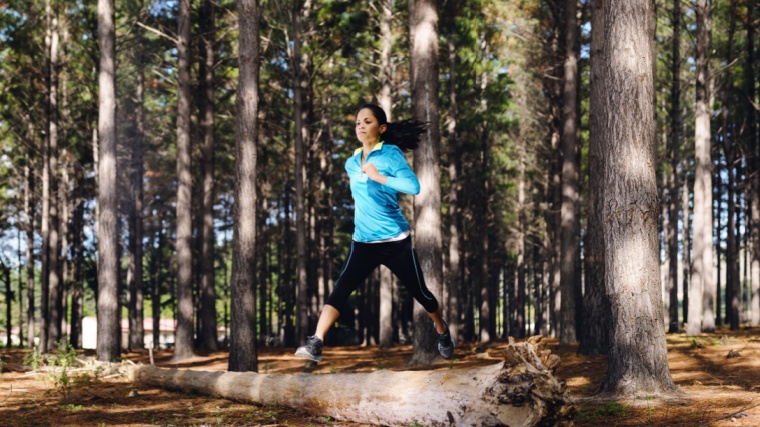Feeling invulnerable after completing your first half marathon, you’ve hopped online and begun searching for a new challenge that’s worthy of your improved aerobic conditioning. Or maybe you’ve been tempted by those looming, paths-through-gorgeous-vistas hills by your house. Either way, you’ve arrived here because you’re interested in trail running — and we’ve got everything you need to know right here.

To get you the best information out there, I called up ultramarathon runner and elite running coach Lee Whitaker. When he’s not guiding his teams to state championships in track & field and cross country, Whitaker is training as an ultrarunner to tackle the most challenging courses in the world. If anyone can help to prepare you for what you’ll encounter out on the trails, it’s him. Let’s dive — erm, run — right into it.
What Is Trail Running?
Trail running may sound like it’s the simple act of running on trails — and yes, that’s a huge part of it — but it also encompasses any run on an unpaved surface that is harder than sand. By this broader meaning, whether you enjoy mountain running through national parks, or doing Tabata training runs through grassy fields, it all falls under the broad category of trail running.
How to Prepare for Your First Trail Run
Whether you’re engaged in an organized trail race or a casual training run through the woods, a trail run is quite different from a run on a track, treadmill, or jog down a city street. While there are always hazards or environmental conditions to be cautious of, those problems are magnified several times over during trail runs. The physical and mental preparations are also quite different.
Know What to Wear
From the ankles up, your attire for a trail run won’t vary significantly from what you ordinarily wear during runs unless you go out for an extended period (more on that in a minute). From the ankles down, you’ll want to pay very close attention to your shoes and socks. Not only can they make or break your run, but they might even help prevent you from breaking a bone.
[Read More: The Best Stability Running Shoes]
“Out on the trail you might have to cross a stream, or there might be a lot of mud and water out there,” explains Whitaker. “A good pair of running socks will wick the moisture away from your feet and prevent rubbing or blistering. A good pair of trail shoes will be very helpful. You can use regular running shoes on the trail if it’s dry and not super technical, but if it’s a technical trail with lots of rocks and roots, or it’s wet, you need shoes with more stability and more support, with treads on the bottom that will help with traction so you don’t slip. If you wear street running shoes on a wet trail, you’ll slip and slide all over the place, and maybe even trip or twist an ankle.”
Gather What to Bring
Most of the items you include in your running gear would be the same you would include during an ordinary outdoor run. This includes things like sunscreen, bug spray, and potentially a headlamp if you expect to have difficulty seeing or being seen. The difference comes in how isolated you’ll be from nearby water fountains, parks and your local bodega.

[Read More: The Best Water Bottles For Sports, Flip Tops, and More]
“When you go out on a trail, you’re going to be remote. If you’re going for a long time, you may need to carry more fluids, calories, and electrolytes with you,” suggests Whitaker. “In that situation, you may need to wear a vest that carries water and food or snacks because of how remote you are. If you were going out on the street, you’d probably pass a park with a water fountain, or you might pass a convenience store where you can grab a drink or some extra calories or something like that. If you’re going on a long trail run through the woods, you won’t have those options available.”
Start Preparing Your Body
You may think that switching your running environment from the road to the trail only changes your scenery, but it also changes a lot about the way your body responds to running. Be forewarned that your body is going to feel very different after a trail run, and that’s a good thing. That’s because you’re going to be better conditioned than it would be if you simply stuck to the road. (1)
[Read More: The Best Running Workouts to Level Up Your Conditioning]
“The surface of a trail is a great way to work your leg muscles differently,” says Whitaker. “Of course, that depends on the type of trail, but unpaved surfaces are softer and uneven. On some of the technical trails, there are a lot of up-and-down elevation changes. When you get out on the road, you tend to work the same muscles over and over again. On the trail, you get your hip muscles, glutes, and everything else working in different ways that are beneficial to you in the long run.”
Know What to Do After
While you probably began your trail run in a normal state of cleanliness, you will probably notice some differences in the state of your clothes and skin once you return to your starting point. To put it bluntly, trail running tends to be a grittier, grimier training option than running indoors or outside on a paved road. For the sake of hygiene, schedule some extra clean-up time for the end of your run.
[Read More: The Best Post-Run Stretches for Your Cool-Down (+ A Stretch Routine From a Personal Trainer)]
“You’ll need to dry or clean your shoes depending on whether the trail was muddy or wet,” states Whitaker. “If you don’t clean, you probably won’t like what you discover if you just toss muddy shoes in the trunk. Your recovery protocol won’t be any different than road running, so icing is fine if something hurts. The big thing you’ll want to do is double-check your skin and clothes for ticks or any other creatures that you don’t want on you. One of my athletes got Rocky Mountain Spotted Fever, and I’ve had a personal friend get Lyme disease. Both are caused by ticks.”
Expert Advice for Beginning Trail Runners
Running on trails is an excellent way to get your workout in while breathing in the great outdoors. But it also comes with its own set of risks. Here’s what to look out for (and avoid).
Ease Yourself In
When you consider the surprising number of different elements involved with trail running, you can understand why a newbie might be intimidated by the thought of trotting along a trail. But if you can manage to jog well on even surfaces, there is likely a trail out there that can accommodate you at your present experience level.
[Read More: Learn How to Run Faster (At Any Skill Level) From a Triathlete Coach]
“There isn’t a fitness level you need to achieve before you can run on a trail. Anyone can enjoy and benefit from a trail run,” insists Whitaker. “The exception would be something like a steep mountain trail or very highly technical trail. Outside of this, there are trails out there for any experience level, including beginners. A lot of places will identify running trails similar to ski slopes — easy, [medium], hard, expert, and so forth. There are certainly some mountain trails around that are ridiculously difficult, but there are just as many that [lots of people] can do.”
Stay Engaged
Running on a neatly paved surface allows you to zone out — almost like a form of meditation — as you survey the scene. And while being surrounded by nature is certainly relaxing, maintaining awareness of your surroundings is key.

[Read More: How to Achieve Proper Running Form, Explained By Running Coaches]
“Technical trails have lots of rocks or switchback turns where you’re constantly having to turn and go the opposite direction to climb up a hill. You also have roots and mud. This means you have to look where you step constantly,” says Whitaker. “You can’t just gaze ahead for half a mile and get lost in it like you would on a sidewalk. Technical trails have all those obstacles, and you’ve got to watch every single step and monitor where you’re going. Otherwise, you’re [likely] to fall, trip, twist an ankle, or something worse.”
Carry a Map
If you decide that the best trail for running in your area is within the boundaries of a state park, that’s a great thing. This isn’t necessarily because of the natural beauty, although there is sure to be plenty of that. But the other reason here is that most state parks supply you with physical maps of their trails. This is important because not every running trail is clearly defined (or has a signal for your phone’s data).
Whether there is a clear definition or not, resist any temptations to veer off the clearly-tread path. You don’t want to do any damage to local plants or to animal habitats — or expose yourself to any unnecessary risks — so stick to the trail itself.
[Read More: The Best Leg Exercises and Workouts for Stronger Legs]
“I would tell any trail runner to study the map of the trail and know where they’re going so they don’t get lost,” advises Whitaker. “On the road, you kind of know where it’s going. When you get down on some of these trails, and it’s heavily wooded, and it’s changing direction constantly, it’s a lot easier to get lost. So you really need to know where you’re going and understand the trail system. And if at all possible, carry a map.”
Don’t Worry About Your Pace
It’s a natural progression for long-distance runners to make a transition over to trail running, just as it’s a seasonal occurrence for many track athletes to join the cross-country team. When this change occurs, you may feel like you’re not moving with the same speed you display during road running, despite your sky-high heart rate. This is normal, and nothing to be bothered by.
[Read More: The Best Treadmills for Running]
“Don’t think about pace too much if you’re somebody who’s used to running on the road a lot and you’re used to running whatever that pace is,” says Whitaker. “Whatever pace you run [normally], it’s going to be slower on the trail. That’s because it’s a softer surface, and there’s not as much rebound from the stride when it hits the ground. So you’re losing energy return. You can’t get worked up over the fact that you’re usually running an eight-minute mile and now you’re running a 10-minute mile. There’s nothing wrong with you. Most of it is just physics.”
Don’t Go Alone
It’s a wonderful idea to take safety precautions in the form of headlamps and trail shoes, but the safest “accessory” for you to bring on the trail with you is another person. Yes, you’re sure to meet plenty of friendly hikers while you’re out training, but it’s a good idea to have someone you know and trust along for the ride.
“When you’re out on the trails you’re more likely to trip, fall, and injure yourself, or something like that,” cautions Whitaker. “I don’t think people should go out alone if at all possible on the trails. It’s probably good advice for any time you go out running, but especially on the trails because there are more things in the woods that can jump up and get you while you’re out there running on trails.”
Frequently Asked Questions
Whenever you’re embarking on a new aspect of your fitness journey, asking questions is the best thing you can do. And we’ve got the best answers you can get.
What defines a trail run?
Train running usually includes any form of sustained off-road running that does not take place on a paved surface. Under most circumstances, trail running will occur on a defined trail rather than an unworn stretch of grass or land.
Is it OK to trail run every day?
It is perfectly fine to include trail running in your daily workout plan if your body can handle the rigors involved. Many distance-running athletes will spend the vast majority of their time running on trails. This includes cross-country runners, who may spend more than 90 percent of their training time running trails.
Is trail running harder than road running?
In many respects, trail running is harder than road running. This is a consequence of having to manage both ascents and descents on more rugged terrain than you would encounter on a paved road. The one aspect of trail running that is generally easier than road running is that the surfaces of trails tend to lend more cushioning to your feet when they strike the ground.
What should I bring on a long trail run?
On a long trail run, you should bring water — whether it’s in the form of water bottles or a hydration pack — along with electrolytes and your trail running shoes. Depending on the time of day, you may want to bring along a headlamp. You will also need something like a vest to store your items, and for the sake of further safety, you may also wish to bring along a map and a running partner.
Editor’s Note: The content on BarBend is meant to be informative in nature, but it should not be taken as medical advice. When starting a new training regimen and/or diet, it is always a good idea to consult with a trusted medical professional. We are not a medical resource. The opinions and articles on this site are not intended for use as diagnosis, prevention, and/or treatment of health problems. They are not substitutes for consulting a qualified medical professional.
References
- Drum SN, Rappelt L, Held S, Donath L. Effects of Trail Running versus Road Running-Effects on Neuromuscular and Endurance Performance-A Two Arm Randomized Controlled Study. Int J Environ Res Public Health. 2023 Mar 3;20(5):4501.
Featured Image: lzf / Shutterstock